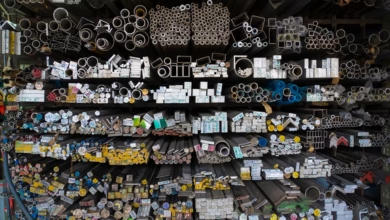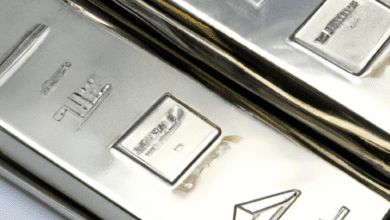Metals in Motion: Navigating Industrial Demand, Investment Strategies, and Sustainable Futures

Metals have long been a cornerstone of both industrial innovation and investment strategies, serving as essential components in a wide array of applications and as valuable assets in financial markets. This article delves into the multifaceted roles of various metals, beginning with silver, which uniquely straddles the line between industrial demand and investment allure. We will explore how copper prices serve as a barometer for global economic health and examine the burgeoning demand for rare earth metals driven by the green energy revolution. Additionally, we will weigh the investment merits of platinum versus palladium, consider how metals can diversify investment portfolios, and analyze the effects of inflation on the pricing of both precious and industrial metals. Lastly, we will look ahead to the future of aluminum within a sustainable economy and discuss how mining regulations shape metal prices. Join us as we uncover the intricate dynamics at play in the metal markets and their implications for investors and industries alike.
- 1. "Silver's Dual Role: Bridging Industrial Demand and Investment Appeal"
- 2. "Copper Prices as Economic Indicators: Understanding Global Trends"
- 3. "The Green Revolution: Rare Earth Metals in the Age of Sustainable Energy"
1. "Silver's Dual Role: Bridging Industrial Demand and Investment Appeal"
Silver plays a unique and multifaceted role in both industrial applications and investment markets, making it a compelling asset for various stakeholders. On one hand, silver is a critical component in numerous industrial processes, including electronics, solar energy, and medical applications. Its excellent conductivity, thermal properties, and resistance to corrosion make it an indispensable material in the production of photovoltaic cells, which are essential for solar panels. As the global push for renewable energy intensifies, the demand for silver in these applications is expected to grow, driven by technological advancements and increased adoption of green technologies.
On the other hand, silver serves as a popular investment vehicle, often seen as a safe haven during times of economic uncertainty. Investors flock to silver as a tangible asset that can hedge against inflation and currency fluctuations, similar to gold. The dual nature of silver—as both a precious metal and an industrial commodity—creates a dynamic interplay between its price movements in the investment market and its demand in various sectors. This relationship means that fluctuations in industrial demand can significantly influence silver prices, while broader economic trends can affect investment sentiment.
As industries continue to evolve and adapt to new technologies, silver's dual role positions it as a vital player in the global economy. Investors and manufacturers alike must consider the implications of these trends, recognizing that silver's value is not solely determined by its investment appeal but also by its critical contributions to industrial innovation and sustainability. This interplay suggests that silver will remain a key asset in diversifying portfolios while also driving growth in emerging industries.
2. "Copper Prices as Economic Indicators: Understanding Global Trends"
Copper prices are often regarded as a reliable barometer for global economic health, a phenomenon rooted in the metal's widespread use across various industries. As a key component in electrical wiring, plumbing, and construction, fluctuations in copper prices can signal changes in industrial activity and overall economic performance.
When demand for copper rises, it typically indicates growth in manufacturing and construction sectors, suggesting that economies are expanding. Conversely, declining copper prices may reflect slowing economic activity, as reduced demand from industries like construction and electronics can signal potential downturns. Analysts closely monitor these price movements to gauge economic sentiment and predict future trends.
Global factors such as geopolitical tensions, trade policies, and supply chain disruptions can also influence copper prices. For instance, significant production cuts in major copper-producing countries or increased tariffs can lead to price spikes, while economic slowdowns in key markets, like China—the world's largest consumer of copper—can result in price declines.
Furthermore, the rise of green technologies, including electric vehicles and renewable energy systems, is expected to bolster long-term copper demand, further intertwining its price movements with global economic trends. As economies shift toward sustainable practices, the demand for copper may strengthen, reflecting a more resilient economic outlook.
In summary, copper prices serve as a crucial indicator of global economic health, influenced by a complex interplay of industrial demand, geopolitical factors, and emerging trends in technology and sustainability. Investors and policymakers alike pay close attention to these price signals to inform their decisions and strategies in an ever-evolving economic landscape.
3. "The Green Revolution: Rare Earth Metals in the Age of Sustainable Energy"
The transition to sustainable energy is significantly increasing the demand for rare earth metals, which are crucial for the production of green technologies. These metals, including neodymium, dysprosium, and lithium, are essential components in the manufacturing of high-performance magnets, batteries, and catalysts that drive renewable energy systems, electric vehicles (EVs), and energy-efficient appliances.
As the global economy shifts towards greener alternatives, the demand for rare earth metals is projected to rise sharply. For instance, electric vehicles, which rely heavily on rare earth elements for powerful batteries and electric motors, are expected to see exponential growth in sales, thereby boosting the need for these materials. Moreover, the wind energy sector also relies on rare earth magnets for efficient turbine operation, further increasing their importance in the sustainable energy landscape.
However, the supply chain for rare earth metals poses challenges. A significant portion of global production is concentrated in a few countries, particularly China, which dominates the market. This concentration raises concerns over supply security and geopolitical risks. In response, many nations are exploring strategies to diversify their sources of rare earth metals, invest in recycling technologies, and develop alternative materials to mitigate reliance on these critical resources.
The intersection of environmental sustainability and resource extraction also raises questions about the ecological impact of mining activities. As demand surges, responsible mining practices and recycling efforts become imperative to balance economic growth with environmental stewardship. The movement towards a circular economy, where materials are reused and recycled, is gaining traction as a way to reduce the pressure on natural resources while maintaining a steady supply of rare earth metals for the green technologies of the future.
In conclusion, the multifaceted roles of metals in both industrial applications and investment strategies underscore their significance in today’s economy. Silver stands out not only for its diverse industrial uses but also for its appeal as a safe-haven asset, reflecting broader market sentiments. Meanwhile, copper prices serve as a barometer for global economic health, illustrating how fluctuations in demand can signal shifts in economic activity. The rising importance of rare earth metals in green technologies highlights the intersection of environmental sustainability and resource demand, emphasizing the need for responsible sourcing and innovation.
As we weigh the investment potential of platinum versus palladium, it’s essential to consider market dynamics and individual portfolio strategies, particularly in the context of inflation, which can profoundly influence the prices of both precious and industrial metals. Furthermore, the future of aluminum appears promising in a sustainable economy, driven by the demand for lightweight materials in various applications.
Finally, the impact of mining regulations cannot be overlooked, as they play a crucial role in shaping the supply chain and pricing landscape of these metals. As investors and industry stakeholders navigate this complex environment, understanding the interplay between these factors will be key to making informed decisions and capitalizing on emerging opportunities in the metal markets.





